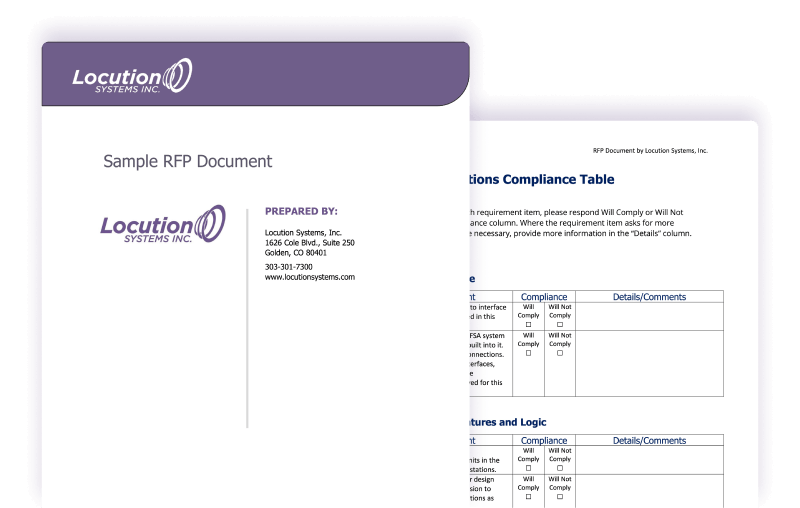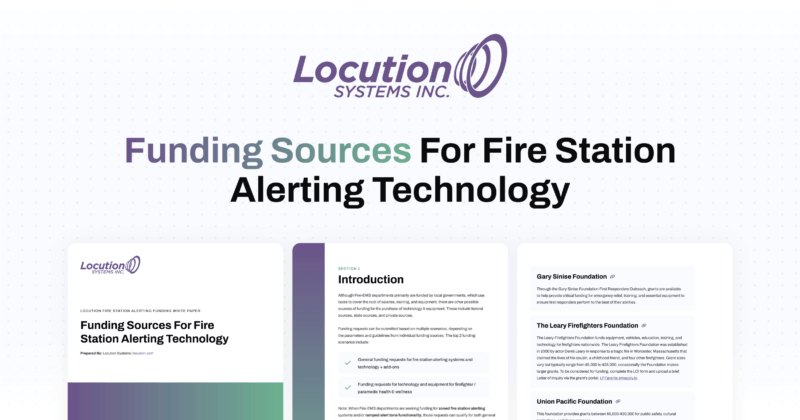Fire Station Alerting
5 Ways to Automate Your Fire/EMS Agency
If there is one thing that 2020 brought to light for Fire/EMS agencies, it is the need to focus on integrating risk-reducing and efficient automated technologies into fire stations. In the article, “5 Ways to Automate Your Fire/EMS Agency” we highlight innovative solutions to optimize first responders’ day-to-day workflows, assess and minimize risks, and help to effectively manage valuable resources. Over the years, automation has been leveraged in the consumer and corporate sectors with measurable success. As a result, use cases are emerging in the public safety sector where reliability is crucial when incorporating automated systems into mission critical workflows.
01. Integrate Automation into a Fire Station Alerting (FSA) system
Fire/EMS agencies should look for an automated Fire Station Alerting (FSA) system to improve dispatch workflows and incident response times. FSA systems are often configurable and are scalable if designed correctly to expand as your organization and needs change. First responders’ health and quality of life will ultimately benefit from a system that offers ramped night vision lighting, ramped tones, and automation of critical tasks. FSA systems do not come as a ‘one size fits all’ solution. Consequently, an agency should consider many factors when selecting an alerting system, including desired outcomes, compatibility with the agency’s existing CAD and radio system, and modularity to scale as the agency evolves. To learn more about determining the best solution, see our recent article “Top 10 Considerations When Choosing an FSA System”.
02. Incorporate GIS technology
Global Information Systems (GIS) is far more than just a map making technology. Offering a wide range of capabilities, GIS provides compelling analysis of a location or assets that empower agencies to better solve problems and make decisions. For example, an agency can quickly collect data (investigative or operational), and see where that data ‘lives’ to report on the information. Companies like esri and GovPilot offer solutions for operations and performance monitoring. The Philadelphia Fire Department uses GIS to innovate within their agency by using the technology to identify and visualize areas where fire and/or emergencies exist before and during an incident. The city also uses GIS to minimize risk to first responders by giving them remote 360° cameras to collect photos at the origin of an incident.
03. Automate your agency’s workflow
Agencies should look for tools designed for managing workflows and tracking assets, inventory, and records at the station to maintain readiness and compliance. As a result, an agency can improve their operational health by using tools that provide checklists, schedulers, and dashboards of assets. Agencies can keep track of personnel, apparatus inventory, PPE, and other vital equipment by utilizing these tools. “Companies like Fire Station Software let you purchase their solutions a la carte, so that you are only paying for the functionality that you need.”
04. Leverage the Internet of Things (IoTs)
Fire/EMS agencies can improve their operations and reduce a variety of risks by leveraging broadband connectivity and the Internet of Things (IoTs). Connecting and collecting data from sensors and systems offers Fire/EMS stations advantages including faster incident alerting and response times along with monitoring apparatus readiness. In a recent article about Smart Cities and the Fire Service, Charles Werner, a 45-year veteran of public safety, predicts that IoT with 5G will make way for a “….comprehensive new connectivity between responders, fire apparatus, and fire stations.” Werner adds that this connectivity will have boundless possibilities for monitoring responder health, accessing the location of missing responders, and much more.
05. Optimize energy efficiency
Like many public and private industries, Fire and EMS agencies strive to become more environmentally conscious. Retrofitting older stations and building new stations with more energy efficient technology is growing in popularity and priority. Retired Battalion Chief Robert Avsec, and now FireRescue author, commented, “…Fire department leaders would be wise to get these energy saving technologies into their fire stations, especially older fire stations, to significantly reduce their energy costs for heating, cooling, and lighting.”
Lighting and thermostat controls can be configured depending on the time of day and can be programmed to detect the occupancy level in a room or zone. In addition, smart thermostats can monitor humidity levels and detect air quality. These automation tools are rapidly becoming more user friendly, and can improve first responders’ health by making stations more comfortable. Matt Conger, Director of Business and Ecosystem Development at Igor explains, “Data is key for understanding your building’s energy consumption. When using a centralized IoT platform such as Nexos by Igor, fire departments can make informed decisions on how to optimize energy outcomes for the station based on how lighting, shading, HVAC, and other systems contribute”.
In Conclusion
With a variety of innovative options for a Fire/EMS station, there is no time like the present to address any operational inefficiencies. As a result, these solutions will help to save time with increasing call volume, improve first responders’ quality of life, and minimize human error.
Like what you see? Share with a friend.
Related Posts
Subscribe Now
Stay Connected with the First Responder Resource Center
Sign up for the First Responder Resource Center from Locution Systems and gain access to valuable insights, industry updates, and expert resources designed to support first responders. Simply enter your information on the right, and you’ll receive exclusive content, news, and updates straight to your inbox. Stay informed and connected—join today!


